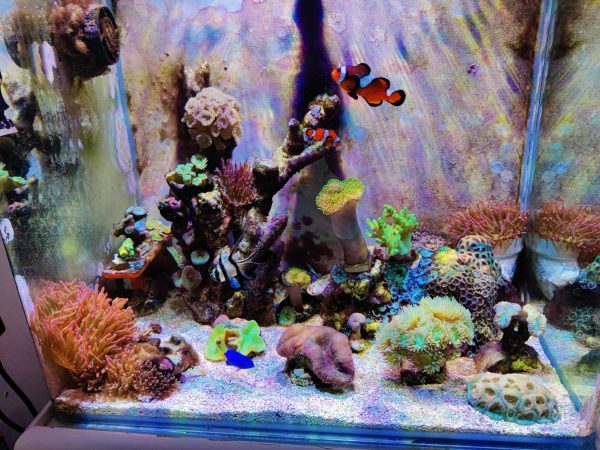ADHD Makes School Different
October 13, 2022
Take a look around at your average classroom. It isn’t hard to spot a handful of students tapping their feet and twirling their pencils as their eyes wander restlessly. But am I painting the picture of a classroom that is simply uninteresting, or is there an all-too-common issue that teachers fail to recognize? With 9.4 percent, or 6.1 million kids, being diagnosed with Attention Deficit Hyperactivity Disorder (ADHD), it is one of the most common neurodevelopmental disorders found in childhood. On top of that, the statistic only accounts for kids who are properly diagnosed, with ADHD symptoms frequently being shrugged off by many parents who don’t see it as a big enough issue to be treated. Despite how common the disorder and its symptoms are, there seems to be a lack of acknowledgement of the struggles associated with it. This is especially concerning in a school environment, where many fail to understand why ADHD seems to become particularly apparent in these settings.
To understand this, let’s first deconstruct what ADHD is and how it presents itself. ADHD can be split into three types of presentations: predominantly inattentive presentation, predominantly hyperactive-impulsive presentation, and (most commonly) combined presentation. Predominantly inattentive presentation was previously labelled and commonly identified as Attention Deficit Disorder (ADD). This presentation consists primarily of struggles in focus and executive function. Executive function is a recurring term in all three presentations, playing a large component in understanding why students with ADHD seem to struggle. We’ll come back to how large of a role this plays later.
Predominantly hyperactive-impulsive presentation, which is more commonly associated with ADHD, consists of outward fidgeting, restlessness, and impulsive behaviors. This form, unlike predominantly inattentive presentation, is usually more visually identifiable. Lastly, and most commonly, there is combined presentation, which tends to show both inattentive presentation and hyperactive-impulsive presentation simultaneously. Let’s put these presentations into the perspective of presenting in students. These presentations can demonstrate themselves at all levels of education. Firstly, you may find a student at the regular level who is social and engaged yet can’t seem to sit still in class and struggles to perform on tests or even finish them on time. In another student you may see little to no attention paid in the classroom, yet excellent results on tests and great understanding of the material. This is often seen on the higher level, where a student may perform outstandingly on tests and assignments, yet frequently falls behind on deadlines. Although these are different experiences, within them, there’s a shared underlying factor.
But first, even with the presentation of ADHD being understood, it begs the question: what is the cause of these struggles? The crazy part is, we don’t really know. Even in the modern age, the full extent of what causes ADHD isn’t fully known. What exactly makes the brain of someone with ADHD different from someone without it? Studies show a correlation between the brains of people with ADHD and the concentration levels of dopamine. Dopamine is a neurotransmitter, known as being the brain’s reward system. It plays a vital role in learning, mood, and movement. It allows for a person to have motivation and helps with focus in learning. With this in mind, it’s easy to see how lacking this vital neurotransmitter can begin to contribute to the symptoms mentioned above. When the brain lacks dopamine, it is in a constant search to receive more. This explains the range of differing symptoms depending on how an individual’s brain compensates for their dopamine deficiency. Inability to grasp concepts can be attributed to dopamine’s role in learning, and the tendency to move more can be attributed to dopamine’s role in movement. The common lack of focus and mental wandering usually attributed to ADHD can now be seen as the brain searching for new stimuli to produce the dopamine it lacks. When the brain is trying to stimulate dopamine, it is more likely to exhibit impulsive behaviors and excessive movement in an attempt to increase dopamine production. This constant, unconscious search for dopamine shapes the way that people with ADHD behave and interact with the world, especially at stages as vital to our development as childhood.
These struggles highlight themselves no more than when attributed to a person’s executive function. Executive function encapsulates the connection between all these different interactions relating to ADHD. With that said, what is executive function, and why is it so important? Executive function refers to the mental, cognitive processes vital in cognitive control of behavior. They are the makeup of a person’s self regulatory skills. There are many executive functions your brain is responsible for, but it has three primary functions: working memory, mental flexibility, and self-control. Working memory accounts for the ability to recall and retain information for a short period of time. Mental flexibility is the ability to sustain or shift one’s focus, even maintaining multiple concepts simultaneously. Lastly, self- control regulates the ability to set priorities, make thorough decisions and resist impulsive actions. These functions are not things we are born with and develop throughout life, especially childhood. The development of these functions can be hindered by a lack of dopamine because of its role in learning and focus, causing executive dysregulation as a child develops. This is where we can begin to directly tie the issues in students to the behaviors that come with ADHD. These behaviors at face value are common in children and are seen as something to “grow out of.” What kids don’t need to be reminded to clean their rooms, pay attention, or not do something reckless? The frustration begins when a student child grows old enough to be aware of their actions and what they should do but cannot control their impulses nor attention span. Having underdeveloped executive functions but growing cognitive awareness and expectations can make students feel trapped in their own minds.
It isn’t difficult to see why these struggles intensify in a school setting. Let’s set up the average classroom structure. You are put in a room, confined to the space of your desk, and spend the majority of your time sitting, staring at either your work or your teachers for 7 to 8 hours. This may not sound drastic, but what I’m describing is an environment with minimal stimuli for the brain. For most students, having little stimuli and just having to listen to your teacher or complete some worksheet sounds boring but not detrimental. The perspective changes, though, when we remember that the lack of stimuli further deprives a student with ADHD of the dopamine that they already lack. This mentally drains a student, as their brain’s lack of executive function debilitates their ability to focus on the only available stimuli given, and they desperately search for something to feed their brains. What is commonly mistaken for simple boredom or lack of interest is, in reality, more akin to mental starvation. This near constant deprivation can put the mind through the ringer. It doesn’t help that when a student finds methods to cope with this, finding outside stimuli like music, drawing, or fidgeting, they are often scolded by teachers for not putting their full focus on their teacher or work.
The commonly looked at solution for ADHD is treatment through medication. Stimulants like Adderall and Ritalin are typically able to help the brain’s ability to focus and can allow students to use their full potential. Problem solved, then, right? Well, no, this actually introduces a plethora of new problems to look at. What medication works best? What dosage should we prescribe to still-developing children? Should we be medicating such young children at all? Do these stimulants have any adverse effects on children’s development? Adderall is the most commonly prescribed medication for ADHD. With an average age of diagnosis for ADHD being 6-12 years old, we can wonder whether prescribing an addictive amphetamine is a good idea, especially considering that the lack of impulse control development found in brains with ADHD make them more susceptible to addiction. Scientists still don’t fully know the long-term effects of Adderall on developing brains, but some studies suggest frequent use increases white matter in the brain and could increase the risks of other neurological disorders. That is not to mention Adderall’s many side effects, such as loss of appetite, nausea, dizziness, headaches, exhaustion, paranoia, and trouble sleeping. Even with medication, there’s no guarantee of improvement. There is a common misconception among teachers and parents that medication will “fix” a student’s ADHD or take away all their struggles. However, this is a disorder, not a cold, and taking some medicine won’t make it all go away. Bearing that in mind, medication isn’t an option to rush into.
As someone who takes a stimulant medication for ADHD, I’d like to clarify that medicating is not a bad solution for ADHD. A person just needs to go into it knowing what to expect, which can be a lot to put on young kids. In my experience, the first week that I took Ritalin, I had strong headaches everyday after my medication wore off. Fortunately, the symptoms lessened as my body adjusted, but the constant lack of appetite and occasional nausea and headaches still affect my day-to-day life. With that in mind, medication should not be the only form of treatment for people with ADHD, as for many, these symptoms can be too much to bear on a day-to-day basis, especially for busy students.
But if medication isn’t a full resolution, what is? Maybe that question is where the problem begins. A resolution suggests that something is fixed and done with, but that is the exact opposite approach to what should be done about these kinds of situations. There is no set solution that one can apply to all students. Students with ADHD (or any disorder, for that matter) can’t be fixed or made to be the same as other students. The best that one can do for someone who is struggling is to be understanding. Listen to your students and make adjustments that will help them. It’s not always easy to understand how our own minds work, but trust that over these many years of trying different methods, we know what has helped. If science doesn’t even fully understand our minds, stop assuming that you do. Stop assuming the worst about students, especially when we know that things that may be distractions for others could potentially help some students focus. For some students, focusing means listening to music or audio as a central noise focus to help them as they work, doodling on their notes to better remember topics, and taking different approaches to learning new subject matter. An open environment for students to communicate helps students, ADHD or not. So for once, have a little faith in us. Maybe a new perspective is the first step towards teachers better understanding students who have ADHD.










